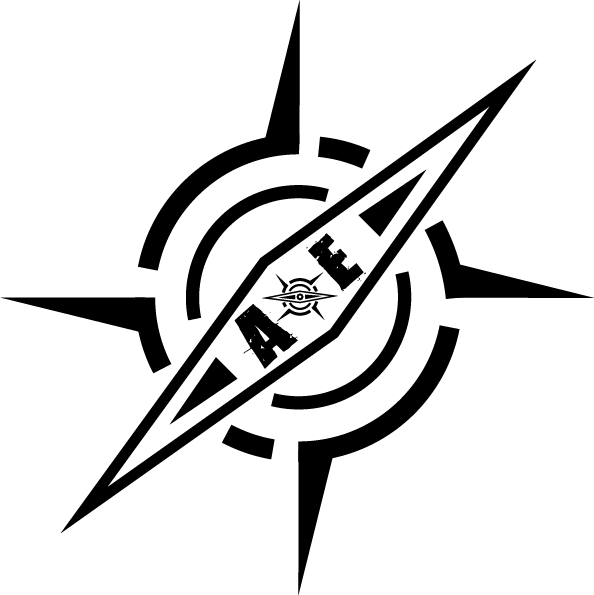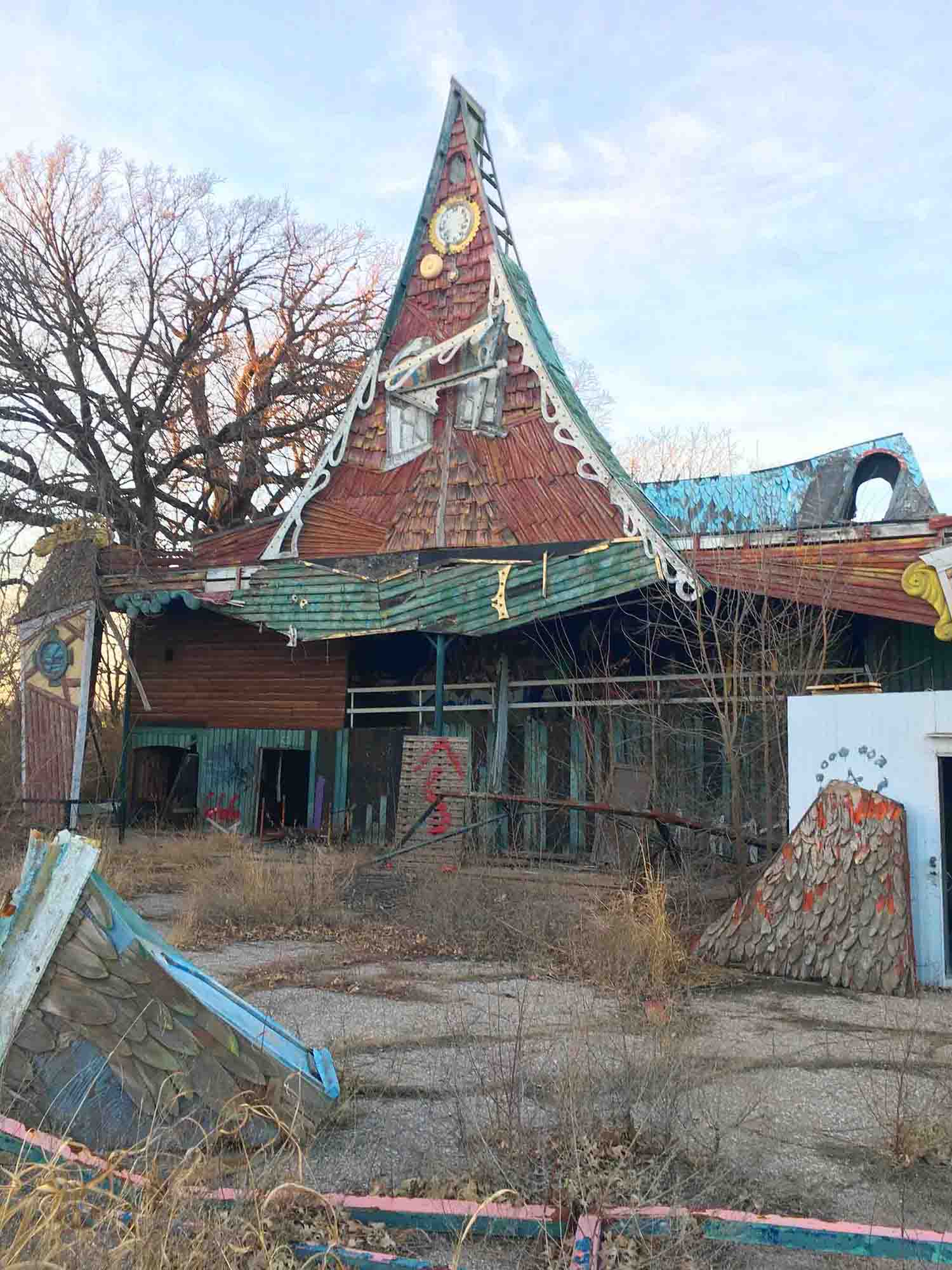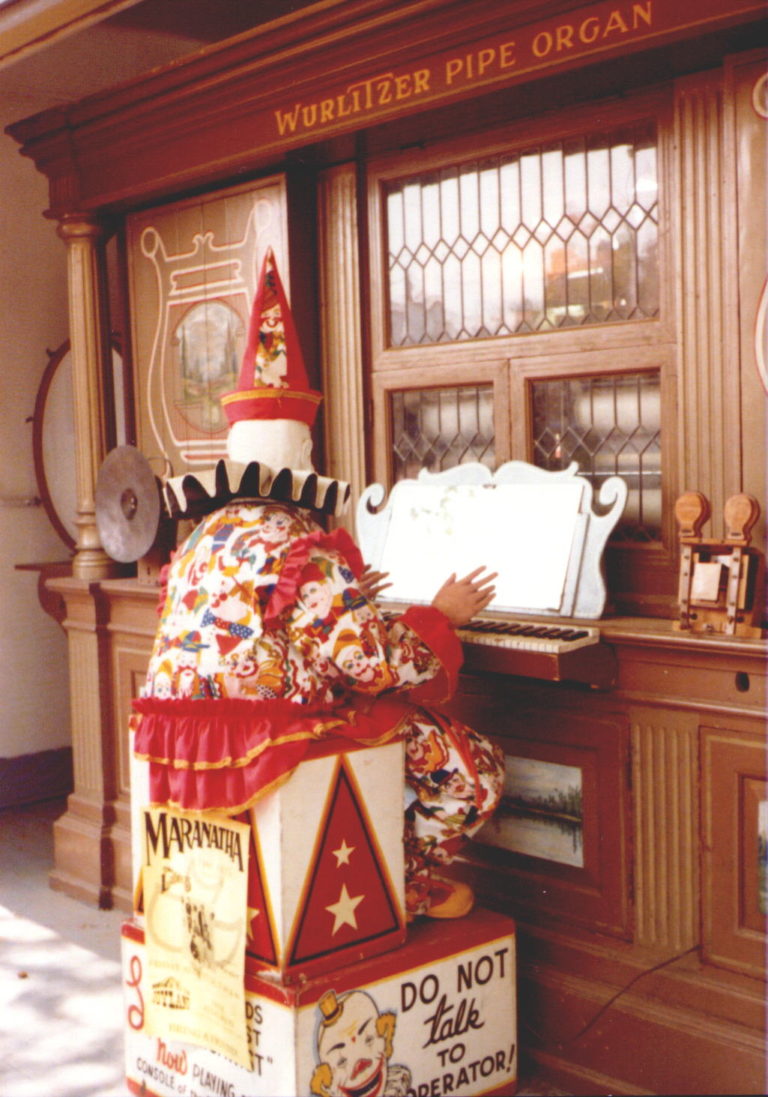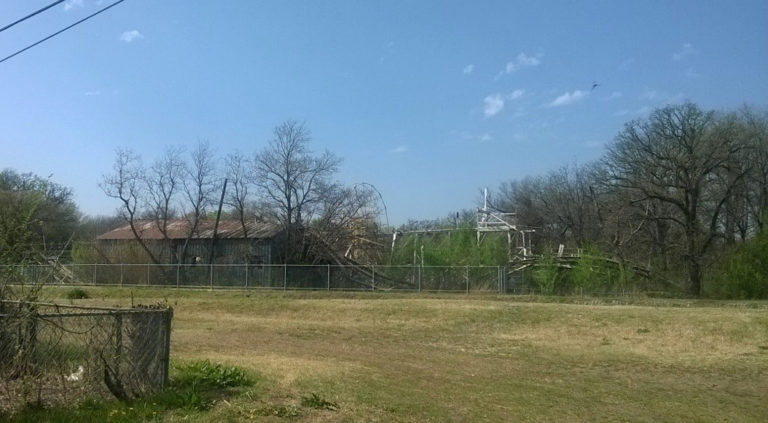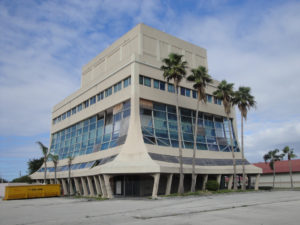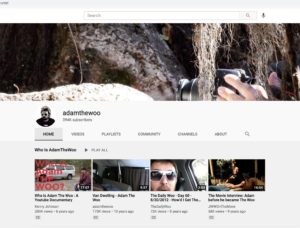
Joyland Amusement Park - Abandoned
The rise and fall of Joyland
2400 E. Wassall St., Wichita, KS 67216
The Beginning of Joyland Park
Joyand’s original founder was Lester Ottaway, a race car builder, along with his sons Herbert and Harold. Lester had purchased a 12 gauge miniature steam locomotive and cars in Fort Scott, KS from a defunct park. The locomotive was built by the Miniature Railway Company of Elgin, Illinois, between 1905 and 1910. In 1934 Ottawa had restored the locomotive and cars and was traveling with the locomotive to county fairs in KS and CO.
On June 12, 1949, Joyland was opened in Wichita, KS and the locomotive was permanently moved to Joyland. It was believed the park was created to give the locomotive a permanent home. After Lester’s death in the 1950s, his three sons, Herbert, Harold, and Eddie continued running the park.
Originally there was a Kiddieland Park located downtown and Joyland was located on the outskirts of the city. In the early fifties the two parks were combined at the Joyland location. The kiddie bumper cars was relocated to Joyland, however it was soon removed and a new ride, the Fright House, was installed.
The park charged an entrance fee and then tickets were purchased for rides. In the last years of the parks operation wrist bands were offered for an all day pass.
Joyland during the Ottaway era
The park at this time featured…
- The Ferris Wheel – manufactured by Eli Bridge Company
- The Roller Coaster
- Dark Ride (Later to be “The Wacky Shack”)
- Dodgem Bumper cars
- The Carousel
- Lester Ottaway’s beloved locomotive
- And numerous other rides, children’s rides and attractions

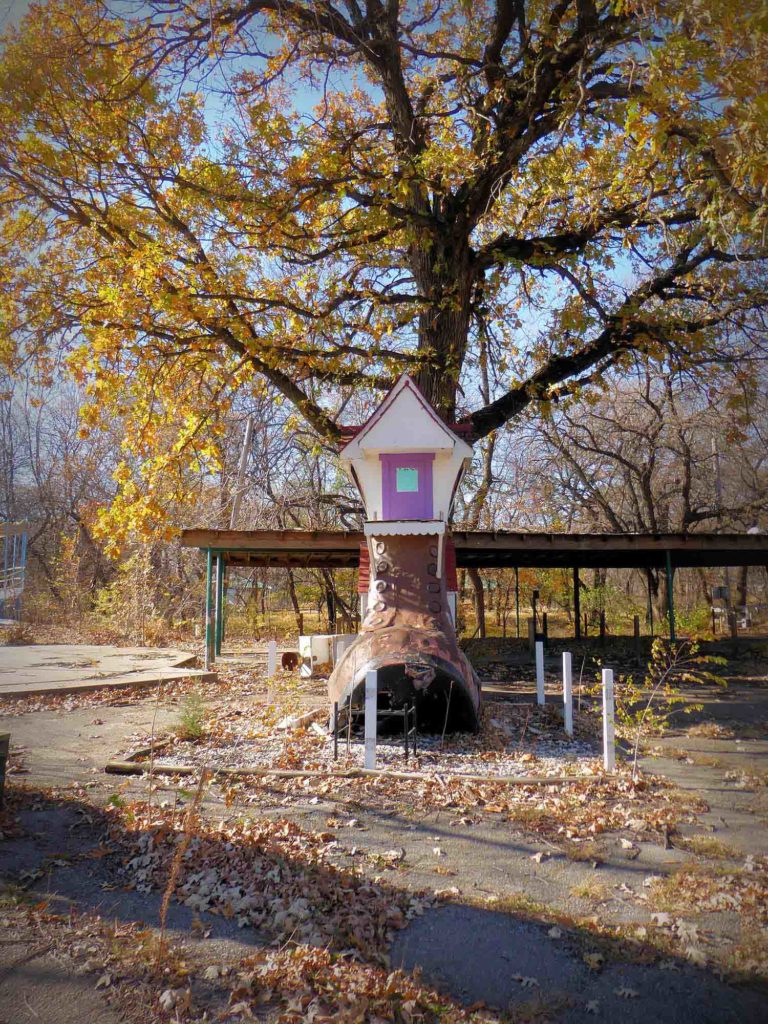


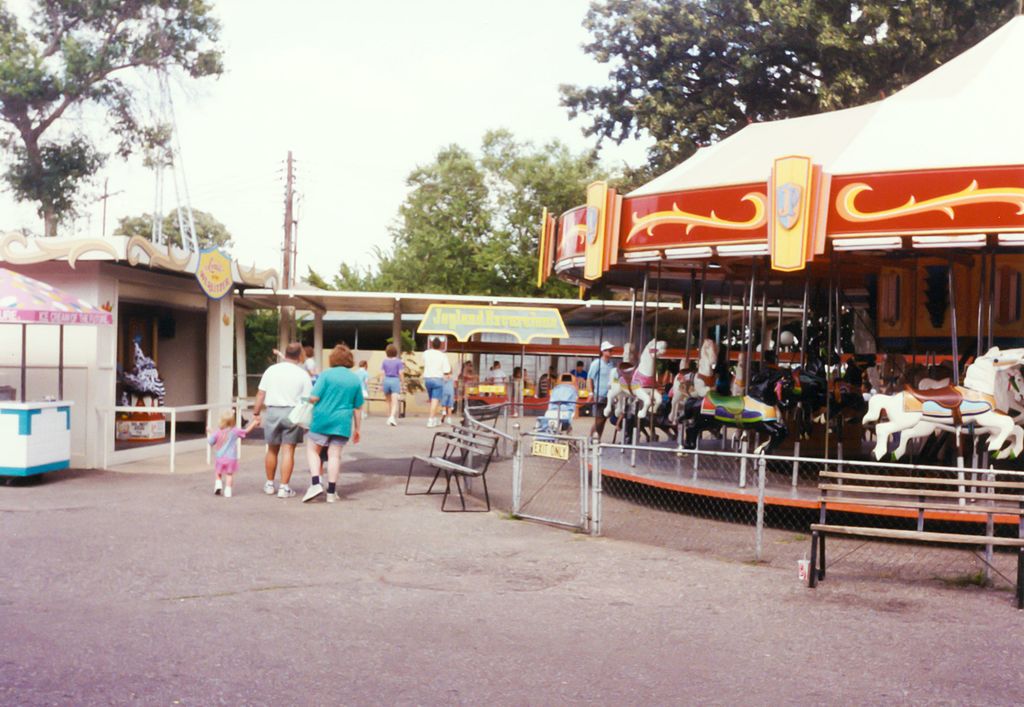
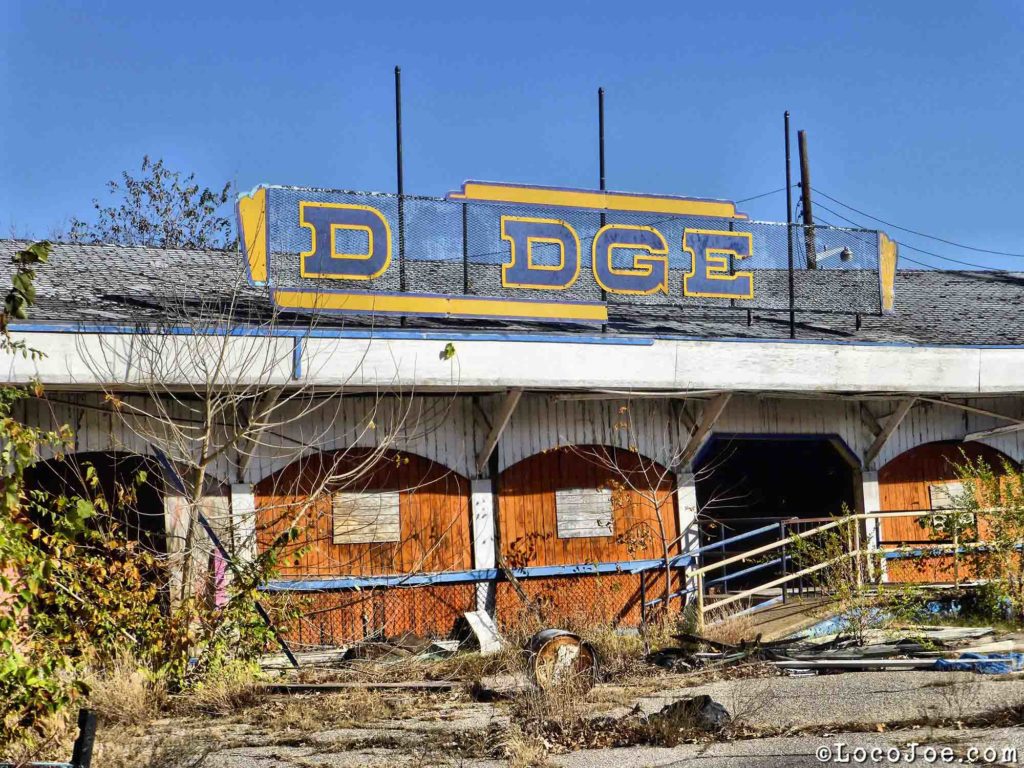
- Roller coaster sign, roller coaster, carousel, Joyland sign By: Patrick Pelletier
- Dodgem, Old Woman’s Shoe – By Randy
The Ferris Wheel
The ferris wheel was manufactured by the Eli Bridge Company & introduced in 1949. It had 16 carriages that took riders up to the 35 foot height of the ride. At night a giant blue star was lit up from the center. Unfortunately In 2004, a young girl fell 30 feet from a carriage and was seriously injured. The Ferris wheel was inspected and found to be in good working condition. The girl’s father stated that the safety bar opened and when she reached for it she fell.
The Coaster
The Coaster, a 1949 era wooden roller, was a Philadelphia Toboggan Company coaster designed by Herbert Paul Schmeck. It was only one of 33 surviving coasters of only 44 original coasters designated as an ACE Coaster Classic. Originally just called Roller Coaster (later given the name the Nightmare). It had a 2,600 Ft. track span, a 75 Ft. drop, and a 50 mph top speed. The coaster also had the distinction of being the only remaining roller coaster in North America using vintage rolling stock with fixed lap bars (no belts until later). The highest point and first main hill was 75 feet. It whipped through trees and valleys and turned around out by the parking lot. It had a few more bunny hops and a surprise dip and it pulled back to the loading dock. The coaster used a skid brake mechanism. Sections of the tracks had brake runs (a section of track meant to slow the coaster). The manually operated brakes were controlled by large levers operated by the ride operator. Underneath of the tracks there was a barrel that was filled with cement that would trip the skid brakes.
The coaster’s big screen debut, the film King Kung, was shot in Wichita and featured some footage of the coaster. Also, although Stephen King’s Joyland novel is not based on Joyland itself, it bears many similarities and of course has Joyland’s name. King did mention in an interview that Canobie Lake Park, an amusement park in Salem, NH, was one of the main sources of inspiration for the novel. But Joyland in Wichita, abandoned, sure makes a nice setting for a Steven King novel.
The coaster also had a very unfortunate accident in 1998. A maintenance man was struck and killed by the coaster. The man was trimming grass under the ride when he stood up between the tracks and was hit in the head by the coaster which had just crested a hill, police said. None of the riders were hurt and the coaster was immediately closed. Although there was nothing wrong with the ride, it was ultimately just a very unfortunate accident.
In 2006 when the park opened under new operators, the coaster was renamed The Nightmare.
In April of 2015 the Coaster sustained extensive wind damage and was dismantled shortly after.
The Fright House
The Fright House was a new ride, a one story fright house, replacing the kiddie bumper cars. It was quickly updated with new gags and converted into a safari type ride with snakes, lions, alligators and other creepy things. It soon became subject to vandalism. Riders would pull off parts of the ride and would be seen wearing the vines from the ride’s decorations. The initial solution of one clever ride operator, was to hide barbed wire in the vines. This was promptly removed and a fence was installed between the ornamentation and the riders. The attraction initially opened using standard dark ride cars, they were changed to rotating pretzel cars. Maintenance problems and motion sick riders ultimately lead to welding the cars to stop the rotation. The pretzel cars were eventually replaced also. Bell’s Amusement Park in Oklahoma built new cars were made of fiberglass and Bell’s own chassis design.
Dodgem Cars
The Dodgem Cars were classic bumper cars. The bumper cars building had removable doors and mirrored walls. Definition of Dodgem Cars on www.thefreedictionary.com – “Dodgem, a small low powered electrically powered vehicle driven on a special platform where there are many others to be dodged.” Later, the cars were to be bumped into one another, thus, “Bumper cars”.
The Carousel
The Carousel was an Allan Herschell Company designed carousel. It was built in 1949 and all the original horses were disassembled every season for repairs and storage. Mrs. Margaret Spear donated the carousel to the Wichita Botanica in May 2014. The Botanica began raising funds to build a pavilion to house the carousel. After 59 years at Joyland, the carousel will once again host children and visitors of all ages to Botanica Gardens. It is only one of five Allan Herschell Carousels remaining in the world. It will be known as Botanica Carousel. The carousel will be totally rewired because all the copper wiring was stolen, and the lighting will be replaced with LED bulbs. Other major work will also be done to the carousel giving it a who new look. Marlene Irvin, Owner of Custom Carving and Restoration, is resorting the 36 horses. She estimates restoring the horses and chariots will take three years.
The Old Woman’s Shoe
The Old Woman’s Shoe was originally in the Kiddy Land park in Wichita and was moved to Joyland when the two parks combined. It’s actually modeled after a combat boot.
Louie the Clown
One very distinctive feature of Joyland was Louie the Clown, an animatronic, who played a Wurlitzer Organ (named Joyland Louie). The Wurlitzer organ with Louie at the keys, was a Mammoth Military Band Organ, also known as a Wurlitzer Style 160. It was the largest of the Wurlitzer’s early band organs. The organ was built around 1905 by the DeKleist Musical Instrument Works and was sold by the Rudolph Wurlitzer Company. It contained 486 wood and brass pipes and used two perforated paper music rolls. The organ created a sound that resonated throughout the entire park, designed to represent a military brass band of 25 musicians. The organ was one of two Mammoth organs in existence and until the park closed, the only one in public view. The Ottaways purchased (for $350.00) the organ from the Brown estate of Coffeyville, KS. It was on the third floor between the ballroom and the skating rink of the Brown Mansion.
After the park closed, the clown went missing. Damian Mayers, a former employee and caretaker of the organ and clown was suspected. The Nelsons would allow Mayers to take the clown home during the winter. He would apply fresh paint and add to the costume.
On February 19, 2015, the Wichita police announced they had recovered Louie the Clown. Louie, valued by police at around $10,000, was recovered by police searching a residence in central Wichita belonging to Damian Mayes, a former park employee who built and renovated organs. Mayer is serving a prison sentence on a 2010 conviction and is scheduled for release in 2028. Facebook postings by Mayer’s sister helped lead police to the residence.
Stanley and Margaret Nelson Era
In 1968 The Ottawa family sold Joyland Park to Stanley and Margaret Nelson. The heyday of Joyland was before television and air conditioning was commonplace. The park offered fried chicken dinners, a swimming pool and steam powered engine shows. Stanley and Margaret met in 1950 while both were working at Joyland (Margaret worked the Skeeball booth, Stanley sold Dodgem tickets.) In 1972, Stanley was the first park owner to become president of the International Association of Amusement Parks and Attractions. He was also instrumental in helping develop safety standards. Stan passed away in 2010 at the age of 87.
Etsy -The Experiment Lab
Check out my Etsy shop for cool handcrafted items including Joyland magnets.
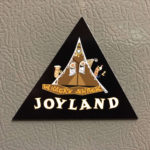
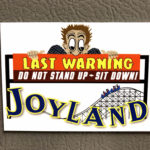
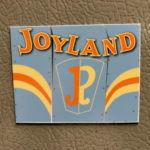
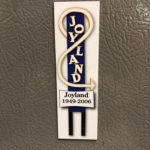


Rides in the Nelson era
- The train
- Ferris Wheel
- Roller Coaster
- Whacky Shack
- Tilt-a-Whirl
- The Log Jam
- Dodgem Classic Bumper Cars
- Roundup
- Zumor
- Paratrooper
- Scrambler
- Dune buggies
- Gunny Sack Giant Slide
- Horse drawn carriages
- Bulgy the Whale
- Circular stock car ride
- Coupe car ride
- Herschel helicopter
- Skycoaster
- Go Karts
More attractive features of Joyland Park were…
- Large picnic area
- Large swimming pool and changing building
- Roller Rink
- Old West Town Square
- Arcade
Joyland had many elements that made the park attractive for company and school picnics and outings such as a large picnic grove and show stage. A local radio station sponsored tickets for grades. I remember going and getting ride tickets with my report card. This inspired a lot of kids to get good grades; A’s meant more tickets. I loved going roller skating and I always went to the school outings and my dad’s work sponsored picnics. When I was little, I thought the Whacky shack was creepy, but to this day, I still remember the cars were painted the most brilliant colors with a sparkling fleck finish.

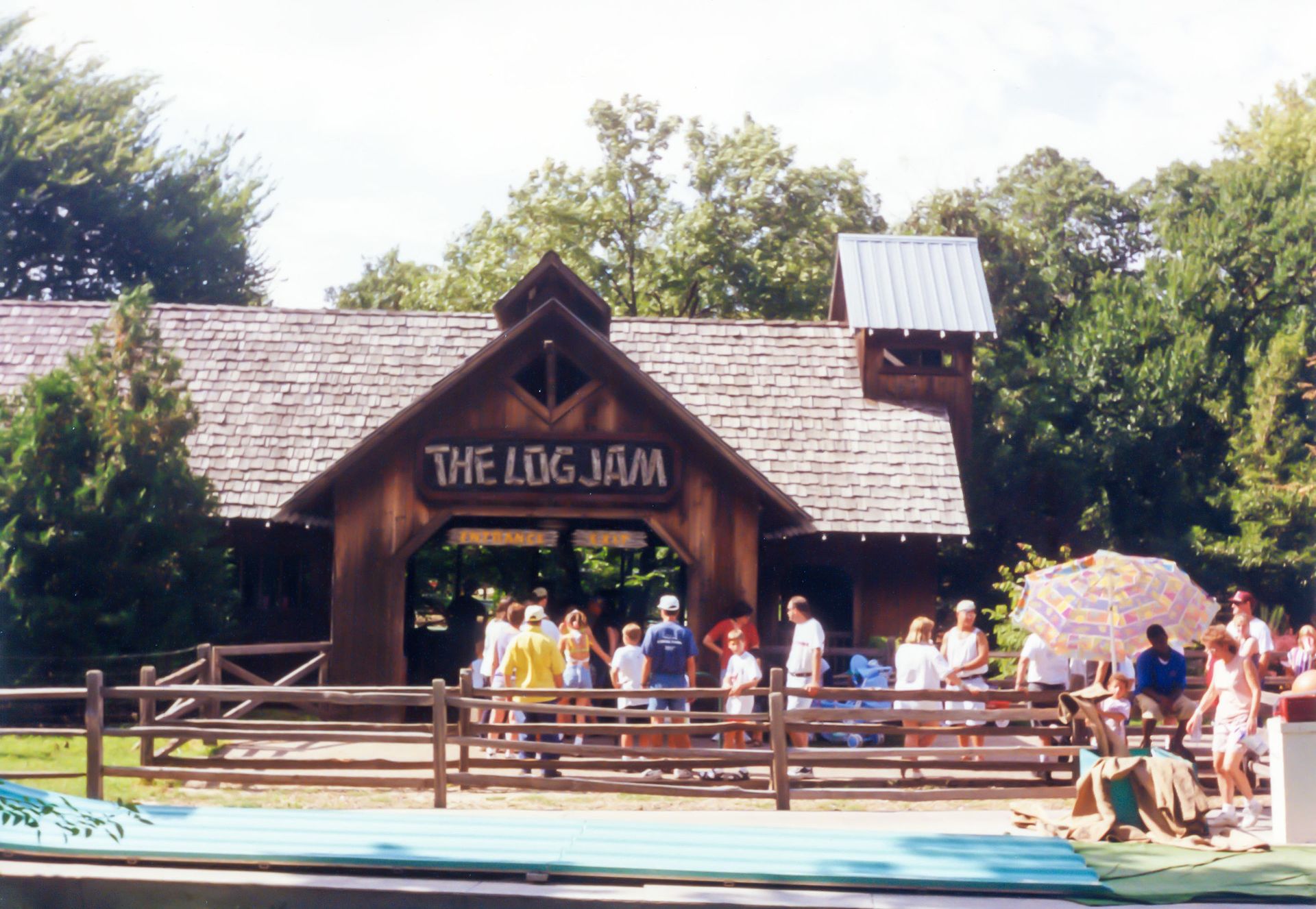


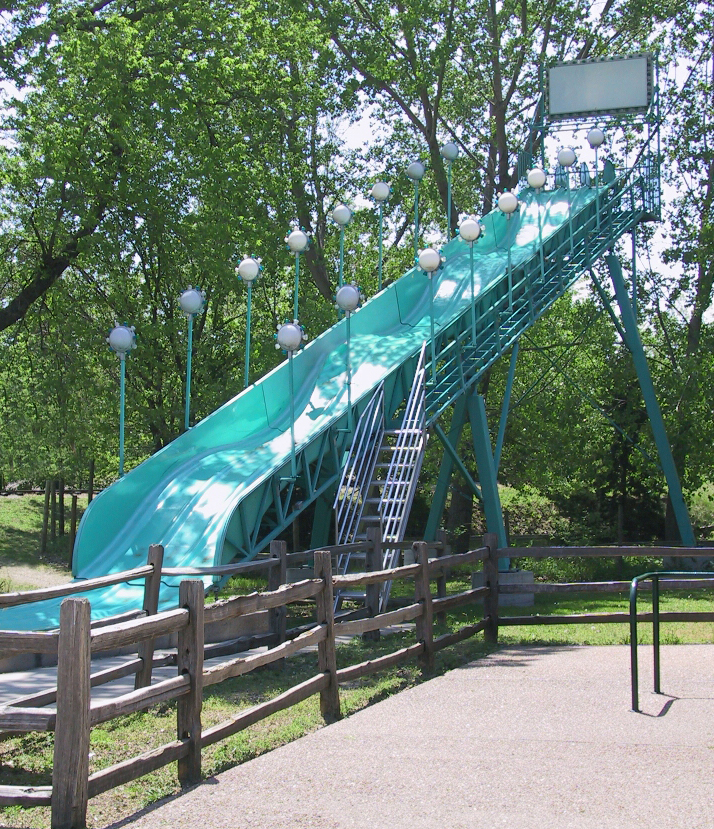
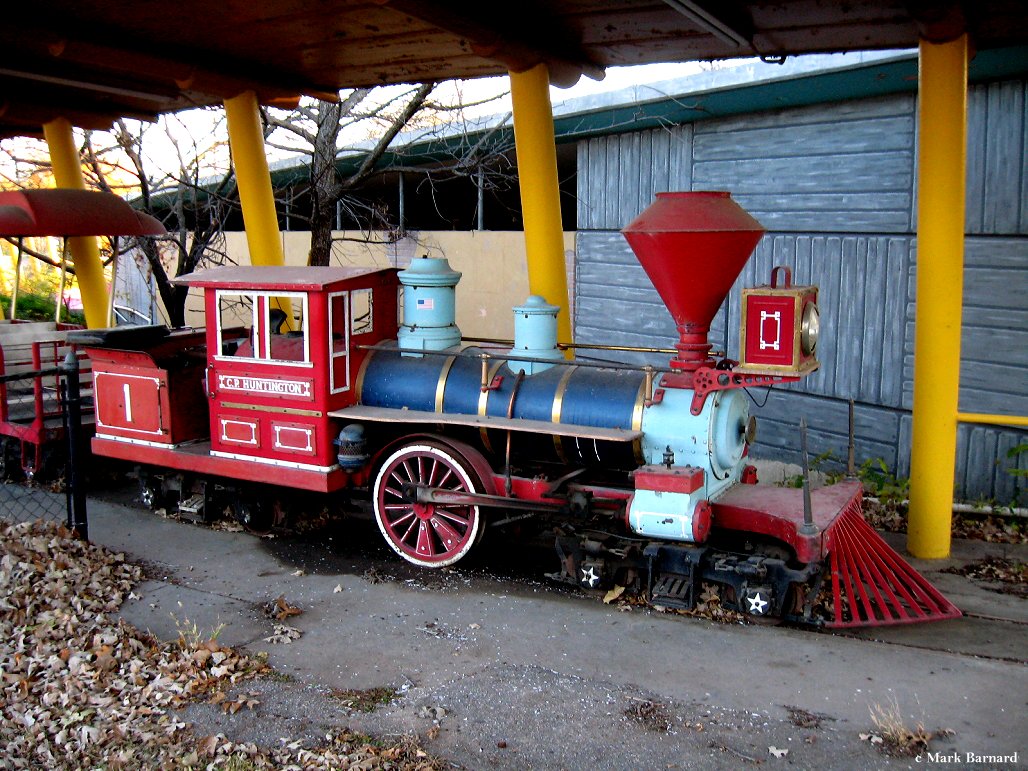
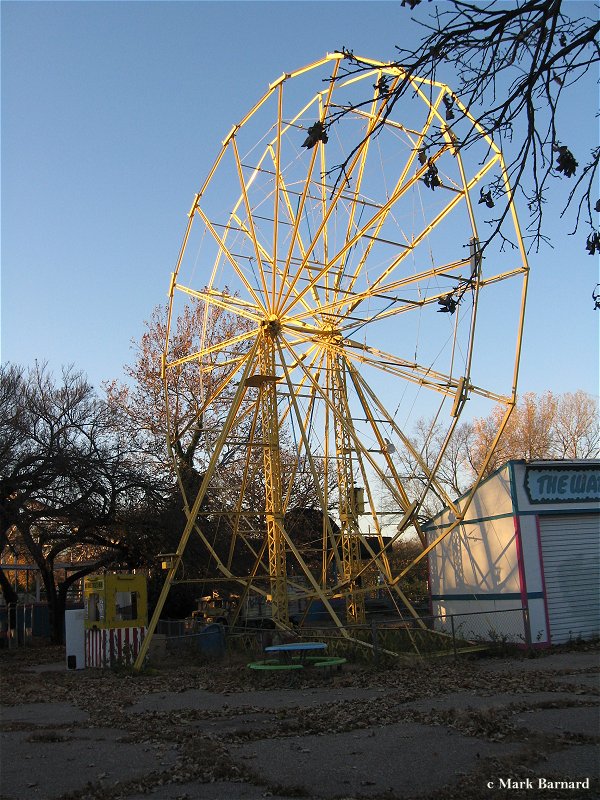
- The Joyland train and ferris wheel by Builder 1975 Flickr: (train) (ferris wheel)
- The Whacky Shack, The Log Jam By: Patrick Pelletier
- Joyland pool and old west town: vintage postcards
The Train
The Ottawa’s miniature train was retired and the Nelson’s brought in the first-ever C. P. Huntington miniature train. It carried the serial number 1 from the factory. CP Huntington Trains can be found at parks all over the world.
The Whacky Shack
One of the most notable and memorable rides was Joyland’s dark ride, the Whacky Shack (opened in 1974). Stan wanted to revamp the dark ride. He commissioned Bill Tracey to design and build the new Whacky Shack. Stan insisted it be exactly like the drawing Bill had made for him. To build the two story ride, they raised the first floor to become the upper level and built a new floor below. Some portions of the old safari ride were left but new scary tricks were what the new Whacky Shack was about. With its crazy whacky exterior it soon became a Joyland favorite and main attraction, aside from the Coaster. Over the years design changes were implemented when maintenance glitches arose. For example people could get out of the cars and the cars would bump into each other. This was remedied by installing a system to shut down the cars if someone got out and to only allow the next car to enter when one came out. The Joyland Whacky Shack was the last one made and Tracy passed away soon after in August of 1974.
The Log Jam
The Log Jam (by O. D. Hopkins) was a classic water flume ride next to the picnic grove. It was refurbished for the 2006 season. The Log Jam was a pretty typical water flume ride, but it did have a unique course that cut through a nicely wooded area and had several splash points. The last splash down was about 50 foot and guaranteed to get the riders wet. In 1997, the park was flooded with six to eight inches of rain water, which was enough to wash several of the log jam cars away. One was found a few days later, but the other one remained undiscovered until 2000. The second car was found seven miles away in the Arkansas River.
The Pool
Over the years new rides were introduced and old attractions were removed to make room for new ones. The Olympic sized swimming pool was added in the 1950s, featuring high dives and a slide. If you forgot your trunks, Joyland sold them. These come up on eBay occasionally. It was closed in 1973 due to city pool competition, other posts I have read suggested a lawsuit shut down the pool. It was used for a period in the 1980s for bumper boats.The pool was filled in and the sky coaster was installed in its place. The pool changing building remained (and it is still there). In 1993 a fire destroyed the skate center. The roller rink was closed and what was salvageable was later used for storage. Across the creek, a go kart track was a hot new attraction.
Porky the Paper Eater
was a well know fixture to Joyland. Porky was a trash can with a pig face in a mushroom. The mouth was a vacuum which would suck the trash out of your hand. Children were amazed and would pick up trash all over just to feed to Porky.
In 1961 Kansas celebrated its centennial and Joyland built its own main street and western store fronts. The old west town was named Frontier Town.
Frontier Town Shoot Out
It featured a general store, general outfitters, a saloon, and costumed cowboys performed entertaining old west shoot outs. This attraction was eventually closed and nature took over. The old western town had an old Aitchison, Topeka and Santa Fe Railway caboose. It was built in 1927 and rolled it’s way into Joyland in the mid 1960s. It weighed 30,000 pounds and the steel undercarriage was another 16,500 pounds. In July of 2015, The Historic Preservation Alliance of Wichita and Sedgwick County moved the caboose for storage and preservation. The Alliance President was disappointed that the car was so vandalized and tagged up. Below is a video of the move.
By 2004 the Joyland Park closed permanently due to economic troubles and safety issues.
After the closing, a Seattle based company , the T-Rex Group leased the property and re-opened the park in 2006. The coaster was renamed “The Nightmare,” the log jam was overhauled and everything was painted in a pink and baby blue color scheme. The park remained open for only one partial season before closing for good.

Preservation
In May 2014, The Historic Preservation Alliance of Wichita and Sedgwick County moved several historic Joyland artifacts including the caboose and the original animated sign that greeted visitors. The sign featured neon light animation of two clowns. They also purchased the Park entrance sign on Hillside, a red bumper car, the stagecoach, the Mother Goose Shoe and the original roller coaster ticket booth that still included the .35 cent ticket price. The artifacts were purchased from the Nelson family in 2010 for $22,000.
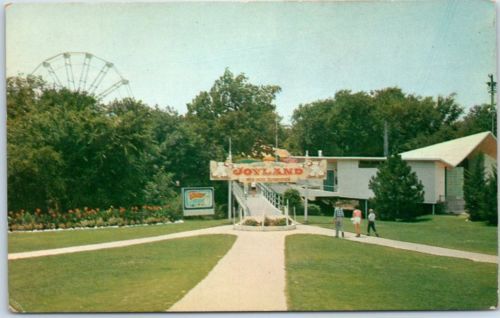
The Alliance also purchased the horse and buggy ride and the whacky shack facade. Unfortunately most of the displays inside the Whacky Shack had been destroyed or stolen. The preservation group was working to keep as many of the remaining local Joyland historical pieces in Kansas. Some of the other memorable park rides had already been sold and dispersed. In 2009 the Nelsons sold the paratrooper, the round-up and the big truck ride. Also in 2009 the “Last Warning Do Not Stand up sign” above the roller coaster was stolen. The marquee Joyland Street sign was removed and in put into storage in June of 2013.
Zombies!
In March of 2015, Margaret Nelson-Spears confirmed that film crews from Georgia were filming a trailer for an upcoming zombie project. She said the group was looking for an amusement park “in bad shape, for a horror film.” They wanted an amusement park that had folded.
There has been no news of anymore footage shot there.
Demolition
On April13, 2015, KSN news reported Joyland Park was being demolished.
– A Wichita icon is being demolished. Wrecking crews are at the old Joyland Park this week continuing to bring down the buildings and hauling them off. The City deemed what was left of the park to be a nuisance, so the owners, the Nelson family, had until the end of May to make significant progress at cleaning it up. The buildings were ripped down and hauled off to the dump.–
July 23, 2015, the remaining parts of the coaster were brought down and removed.
Over the years the park saw tragedies, natural disasters, vandalism, theft and arson. In 1989 a seventeen year old employee was murdered in the parking lot. Then in 1998, the death of the maintenance worker and the 2004 ferris wheel accident. The flood of 1997 caused damage to the entire park and closed it down for weeks. In 2015 a wind storm caused unrepairable damage to the coaster. After the park’s closing in 2006 vandals consistently broke into the park destroying and vandalizing the buildings. As late as April of 2016 a fire destroyed one of the storage buildings containing what appeared to be lumber. In 2012 three teenagers were seen fleeing the park after setting fire to one of the storage buildings. In March 2011, a bathroom building was also destroyed by arson. In 2009 the Joyland opera house, famous for its puppet shows, classic movies and entertainment, was destroyed by fire. Police suspected arson. In April of 2009 vandals destroyed the park office building. Doors were kicked in, windows broken, graffiti sprayed, furniture destroyed. The Nelson family was sickened over all the destruction of their little beloved park.
Ultimately, Joyland, a beloved fixture of Wichita, came to a SAD end.
Economic woes, deteriorating rides and buildings, and a neighborhood giving way to crime and gangs, all contributed to a slow ultimate end to Joyland. Many of the ride parts were stored and salvaged such as the bumper cars and carousel horses. That is why the park is not strewn with tagged bumper cars and ferris wheel buckets. In 2017, the 47 acre property was for sale and listed for $750,000. July of 2017 I visited Joyland and there were still a few things left to see. The Whacky Shack, the big slide, pool house, picnic shelters, the log jam, and the roller coaster loading area and a small portion of tracks were still there. The gates were wide open with no security or signs to keep people away. However it is so overgrown with trees, bushes, and weeds it is mostly unrecognizable. Even the view from the top of the log jam provided only a view of tree tops. There were heaps of debris everywhere and evidence of fires and graffiti at every turn. It is eerie and sad to remember having fun there and now it’s just an abandoned ruin.
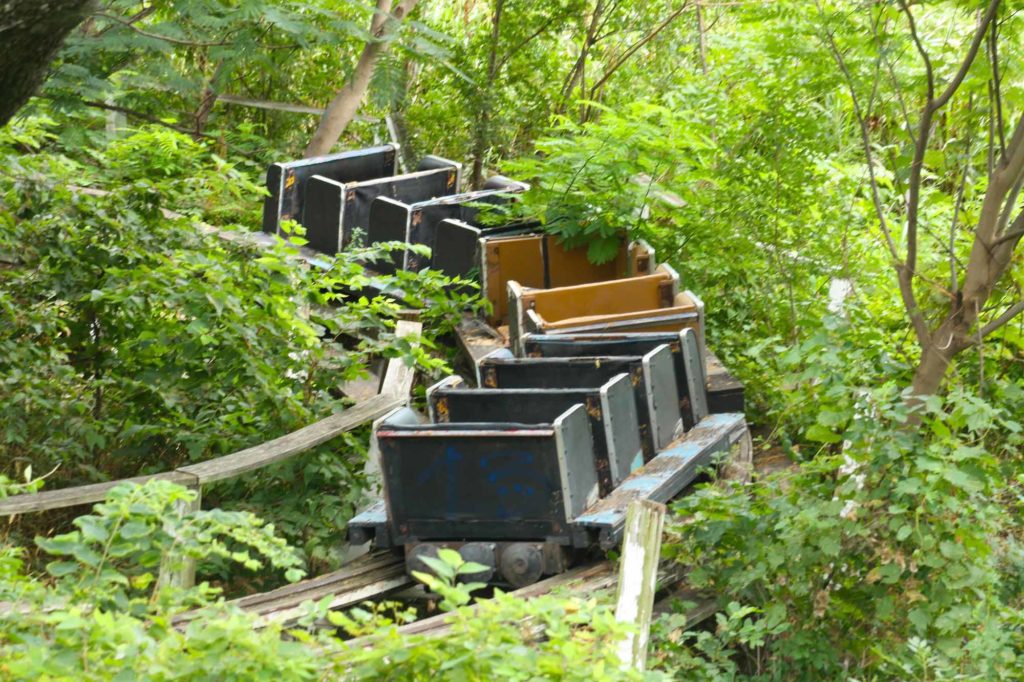
July 30, 2017
The destruction and abandonment of the park is a sad sight. It was eerie and amazing at the same time. The gates and fences were wide open or knocked over and there were many piles of rubble everywhere, that Joyland was hardly recognizable. The first pile of rubble was the Dodgem Cars building, with only the ramp leading up to it remaining. It was demolished sometime between 2013-2015 and any bumper cars were stored away or sold.
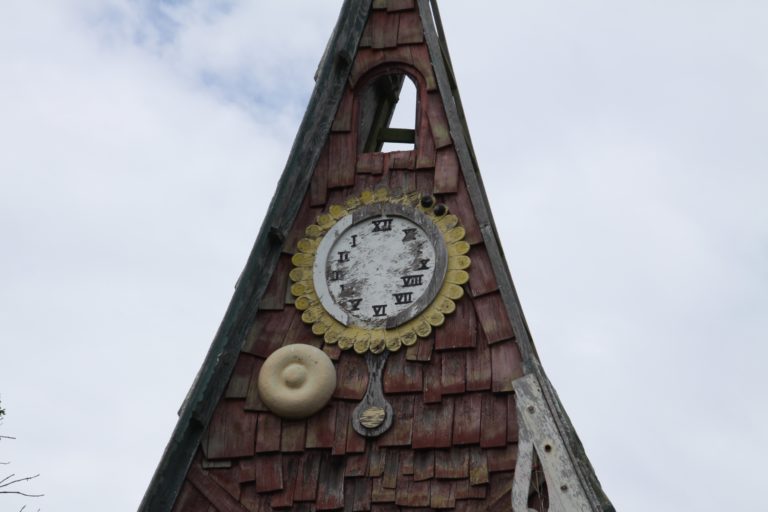
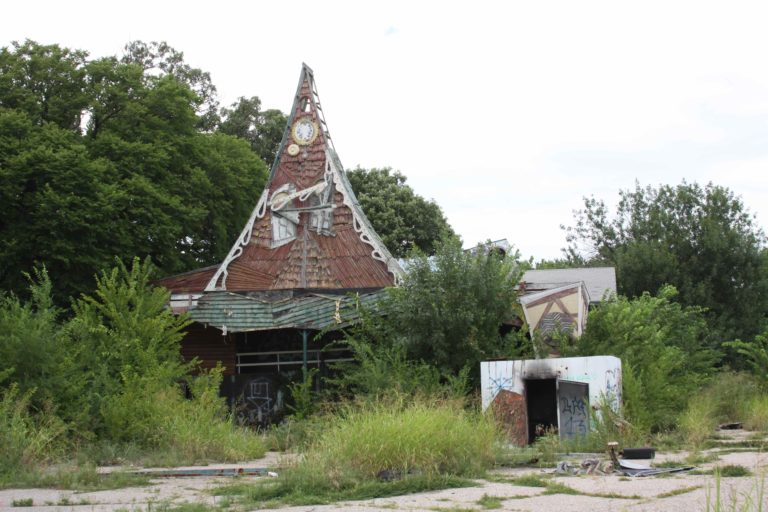
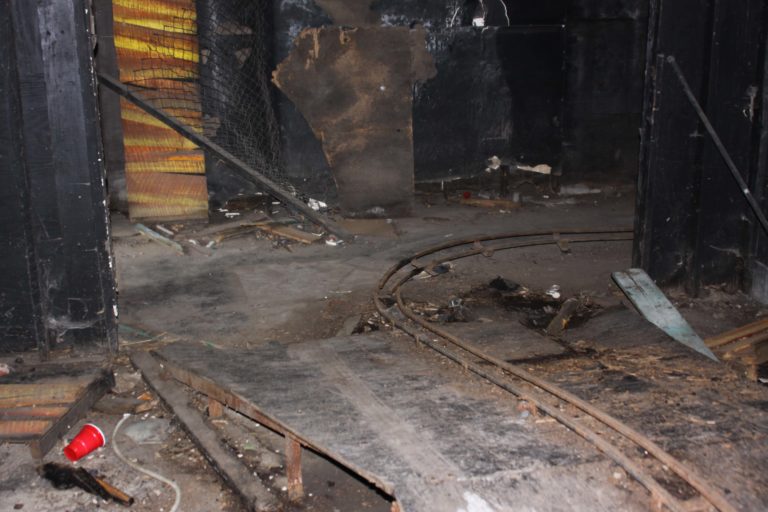

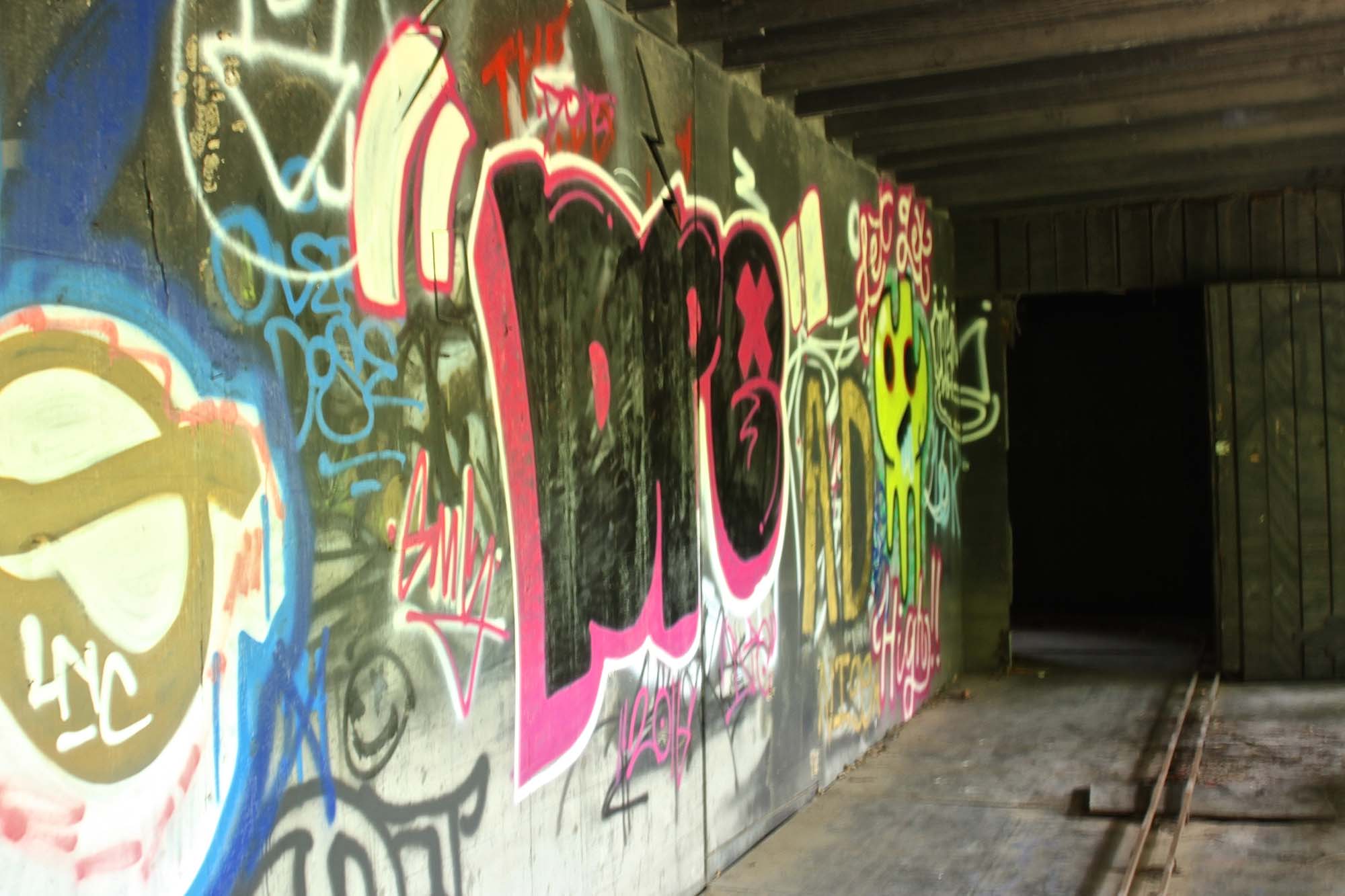
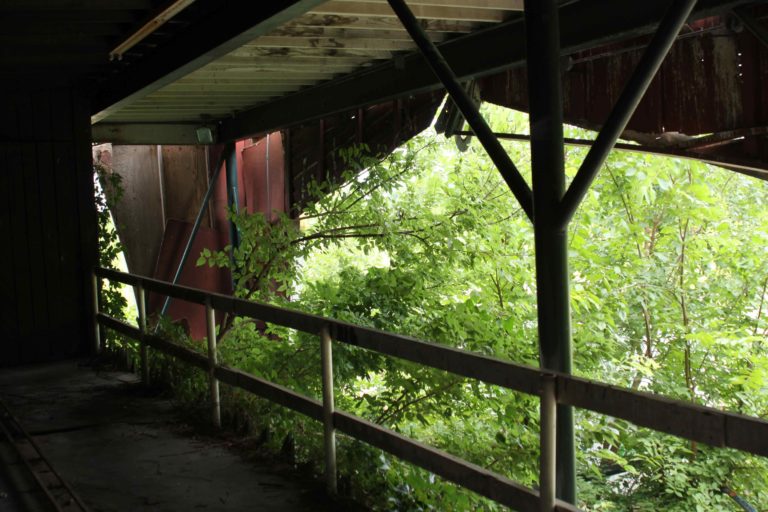
The Whacky Shack sits next to the Dodgem Cars and the building is mainly in tact. The front facade is extremely deteriorated, the decorations are mostly gone, have fallen down, been removed or stolen. The front is tagged up and the inside is strewn with garbage and more graffiti. There are no cars, but the track is mainly there and some of the interior is still decorated. The mine section remains, along with the striped walls and the foil room. Some of the water spray room is still there and the EXIT letters are still on the doors. It is probably somewhat dangerous since it is still very dark inside and there is weather exposure and damage to the building itself.

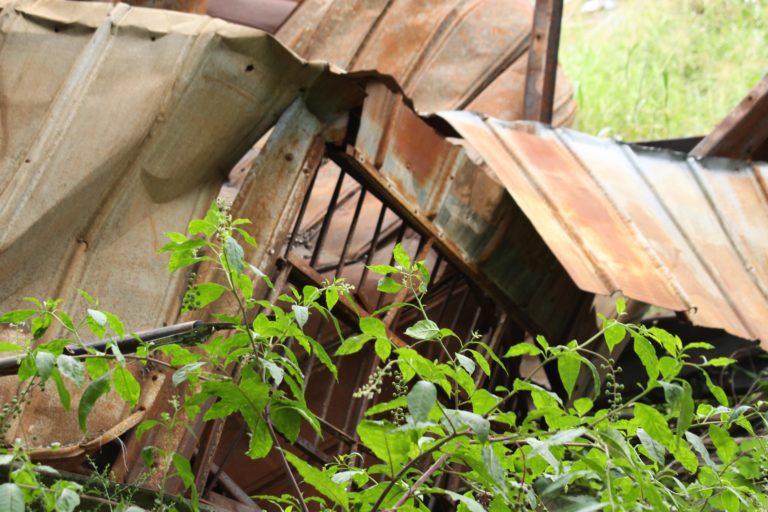
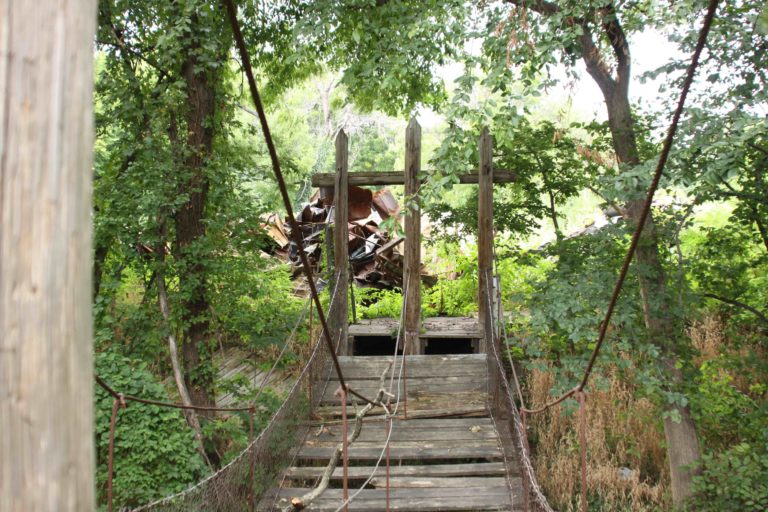
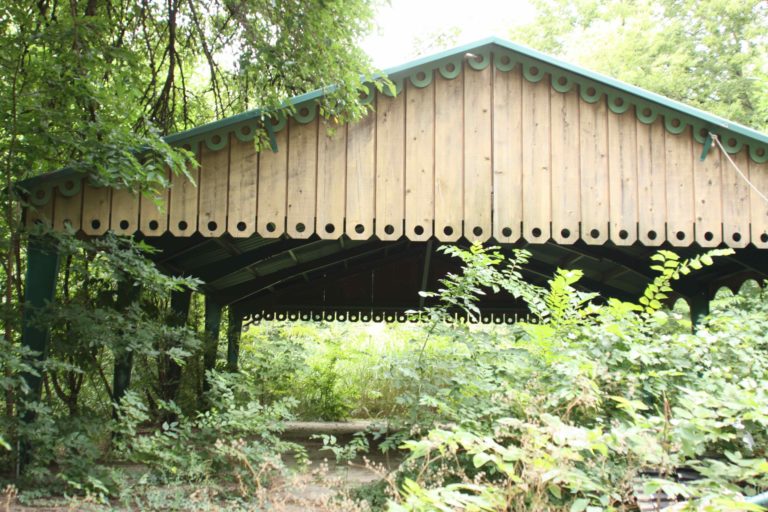
To the west of the whacky shack was two covered areas that had a few old coaster cars under it and brick floor from one of the kiddie rides. The old frontier town is completely gone and lies in several heaps of rubble that is completely overgrown and hidden in the weeds. It is unrecognizable with absolutely nothing left. The Enchanted Forest Bridge is still standing and although it looks sketchy, it is crossable. The dried up creek underneath is only a few feet down.
The oak tree picnic area has two shelters standing by the Log jam’s 50 foot plunge. The shelters are in surprisingly good condition. There are no picnic tables though and no signs of the beautiful shady grove it once was.

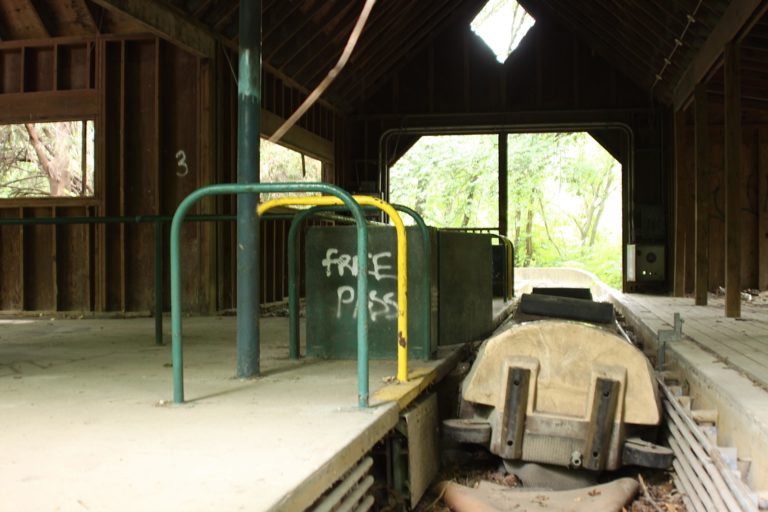
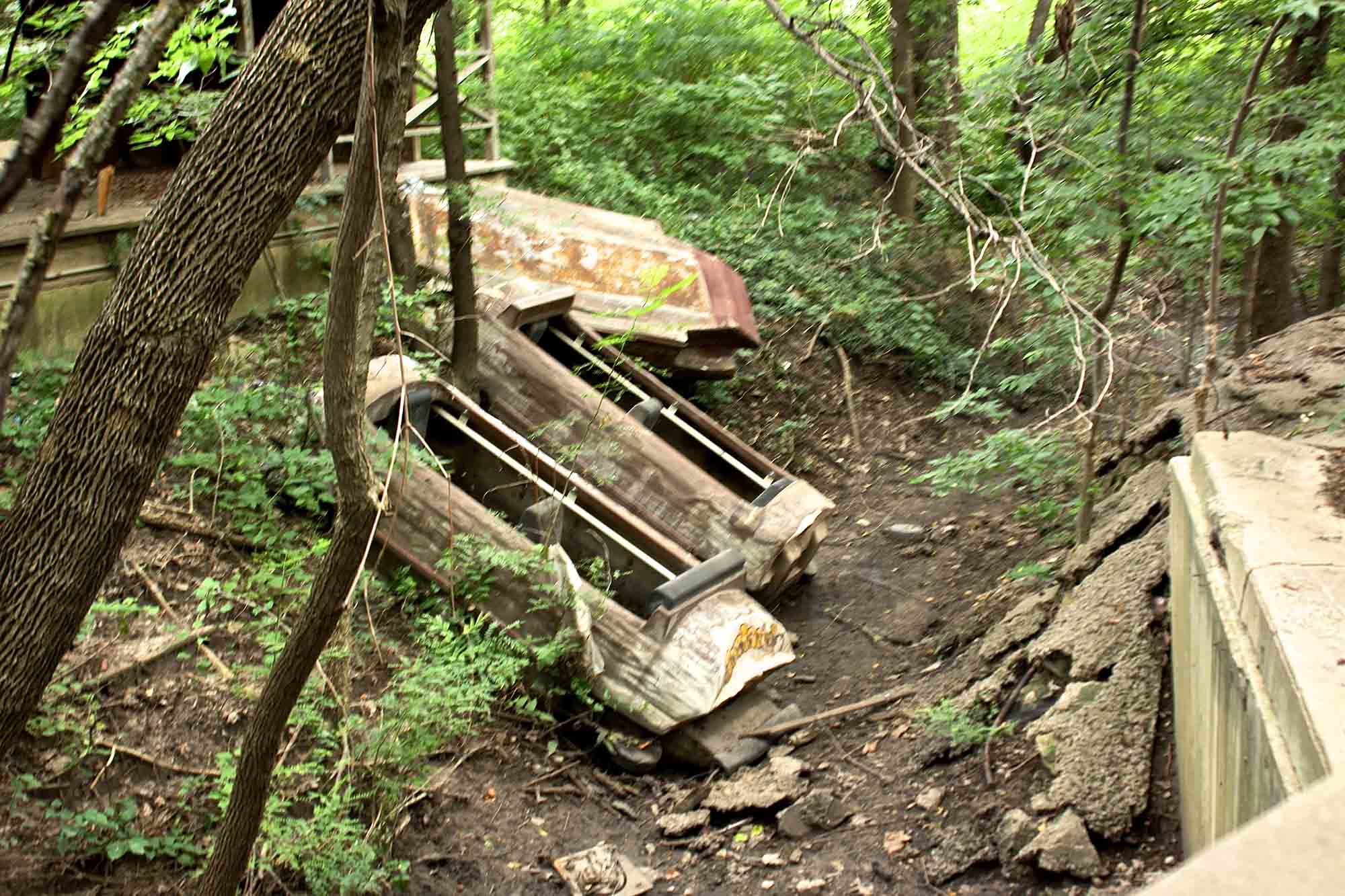
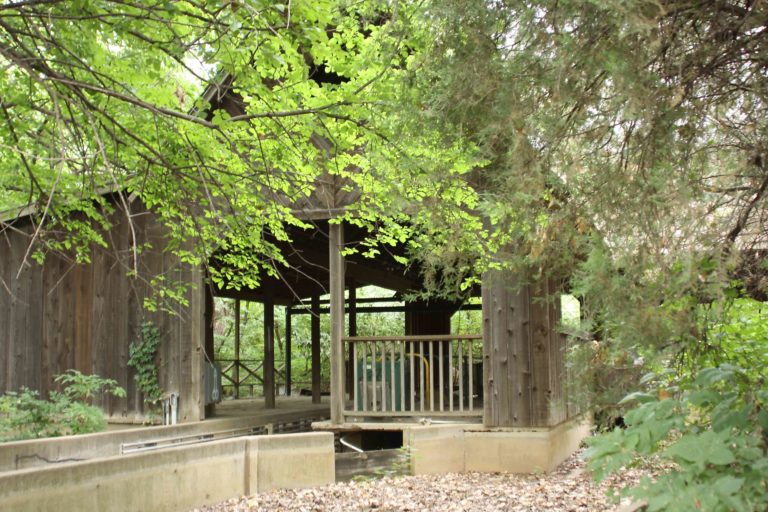
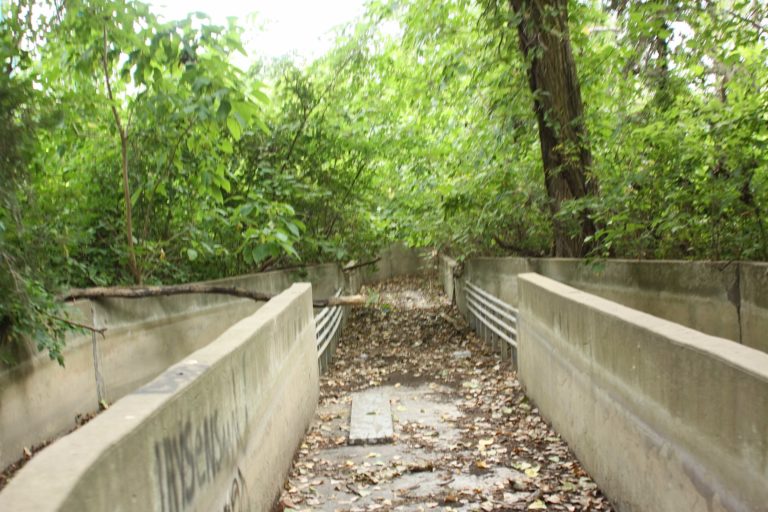
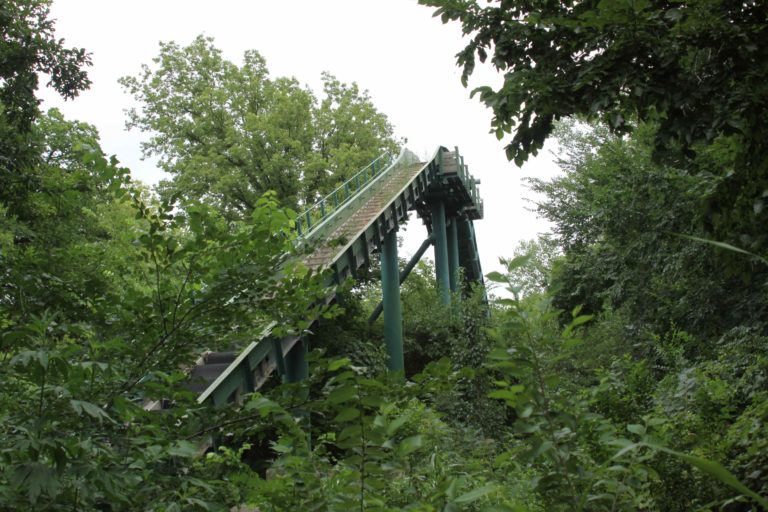
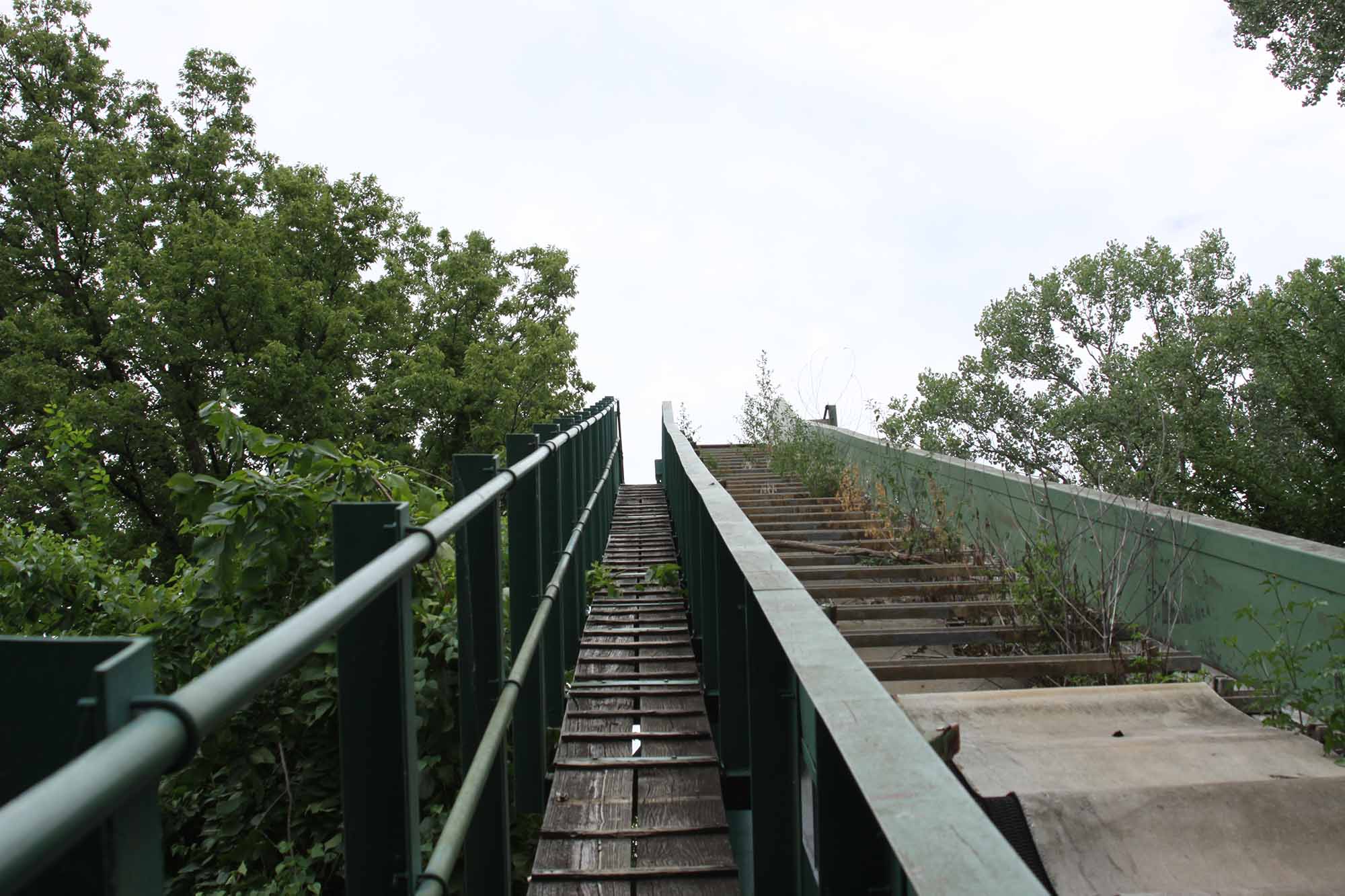
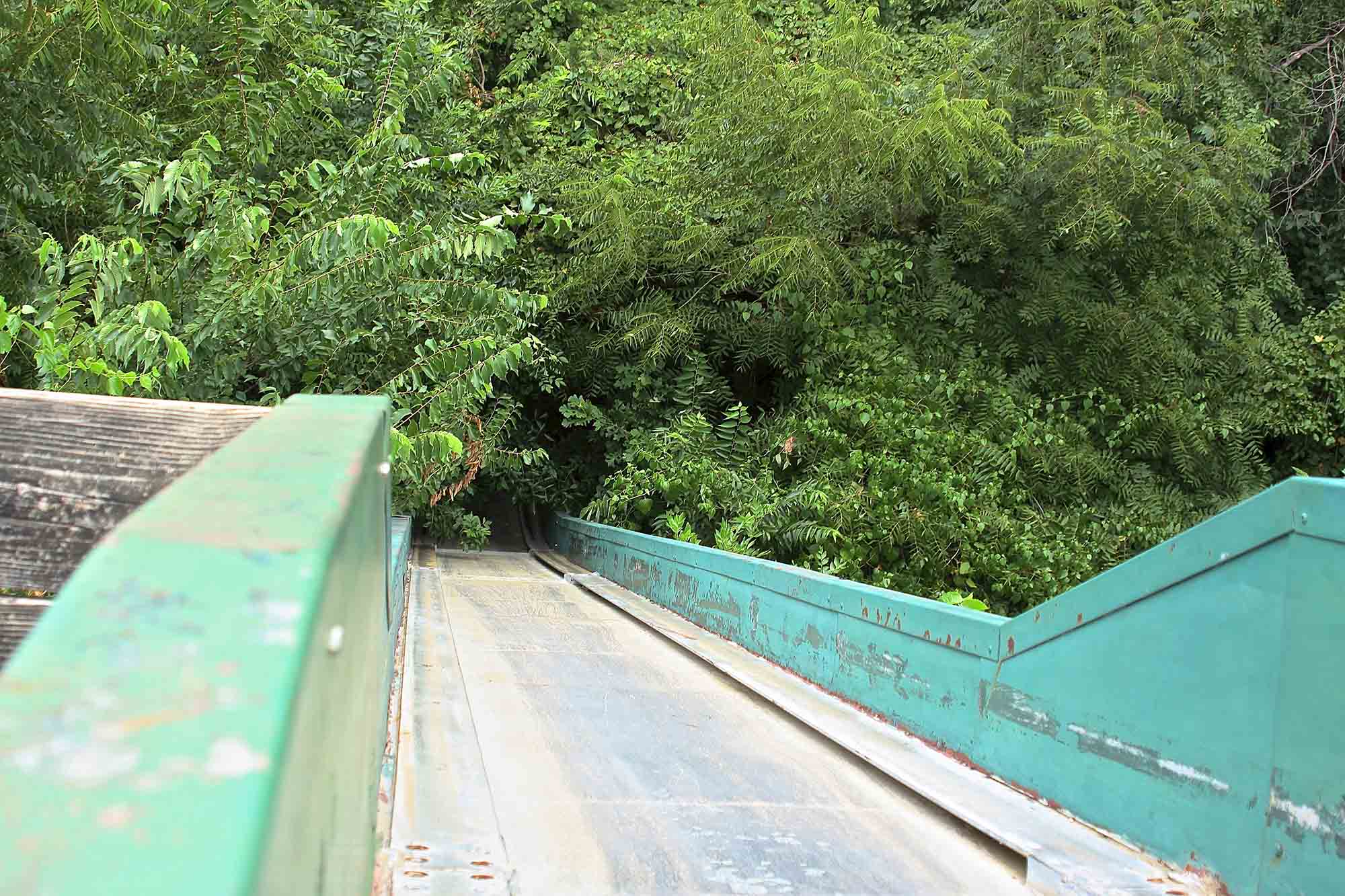
The Log Jam structure seems completely intact, just without water or electrical. The flumes in the shape of logs with Joyland painted on the front of each one, have been tossed into the ravine. There are two still left in the loading dock that are covered with years of dust and dirt. Climbing to the top of the Log Jam’s tall drop is done by the walk way next to the flume conveyor. It looked safe and for the most part it was. But a fall from up there would have been deadly. Under the drop was all concrete and mechanics for the water pumps. A birds eye view from here revealed only trees and a jungle like overgrowth.
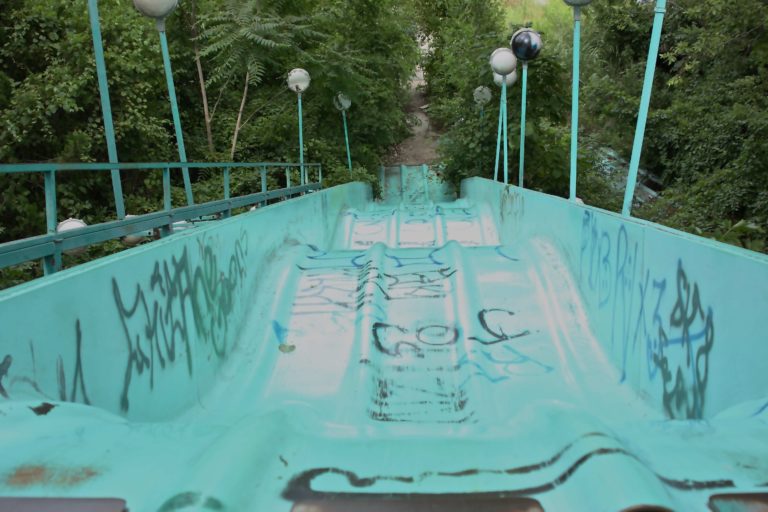

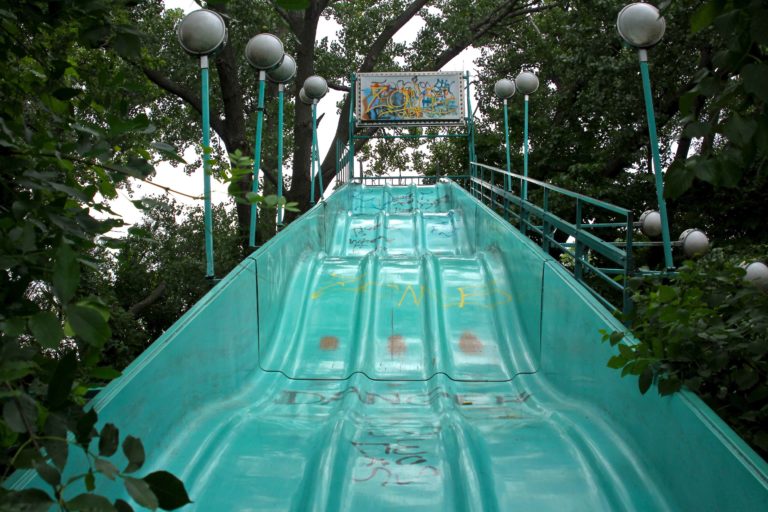
The tall slide was in working condition and we rode down without gunny sacks. Surprisingly the lights on the slide were not stolen or broken. It would seem like the slide could be sold and used elsewhere since it looks to be in good condition.
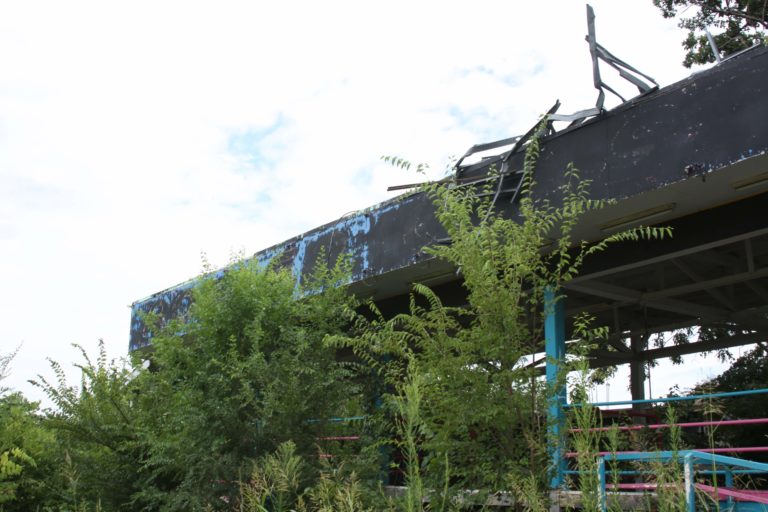
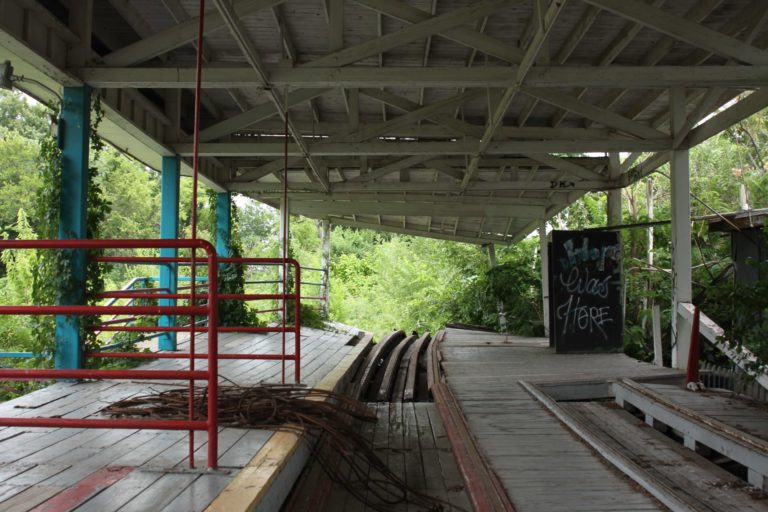
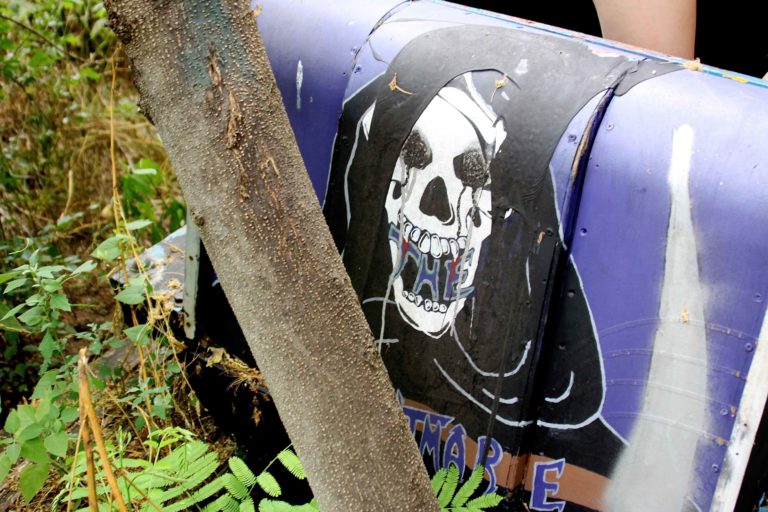
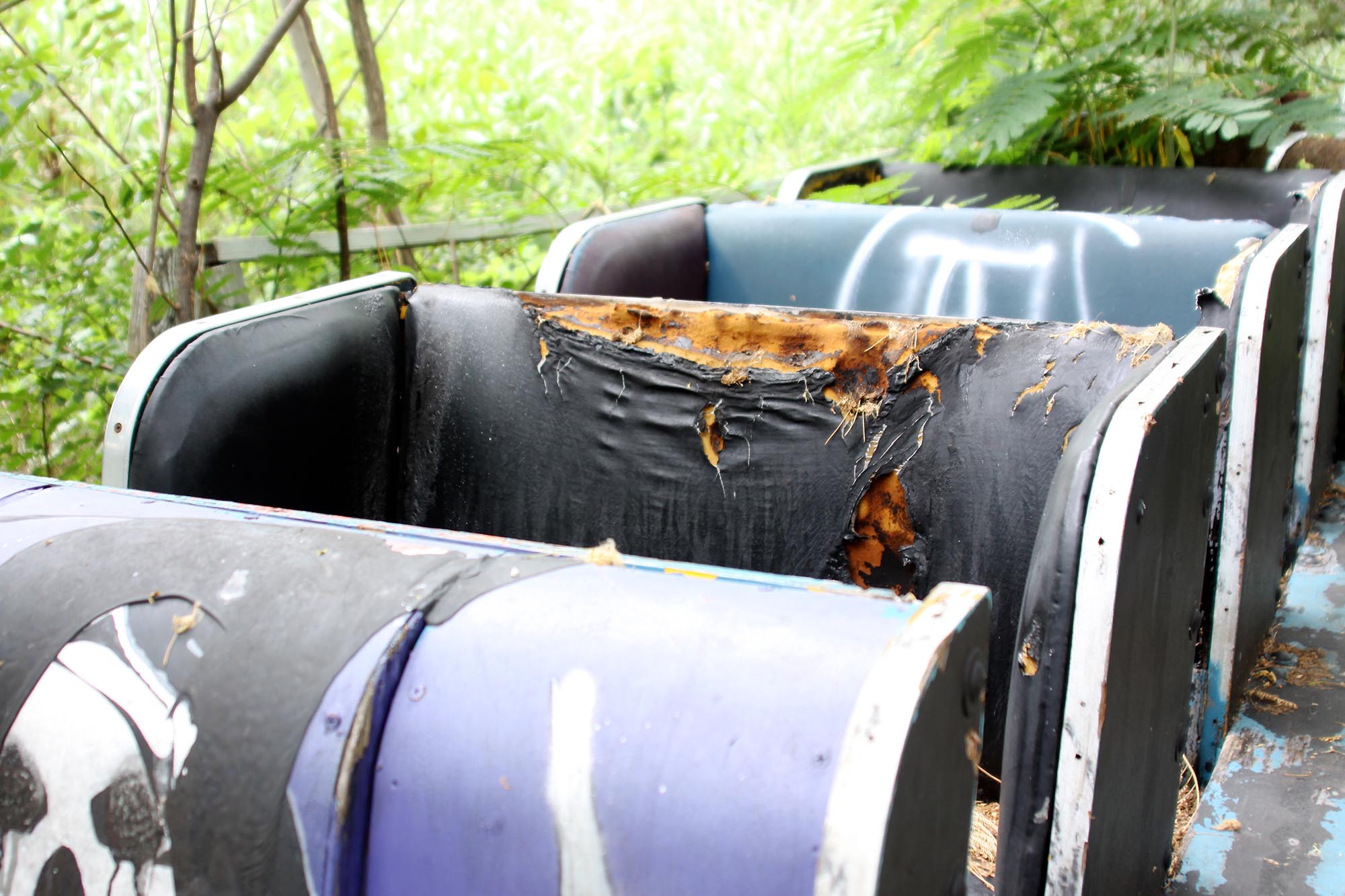
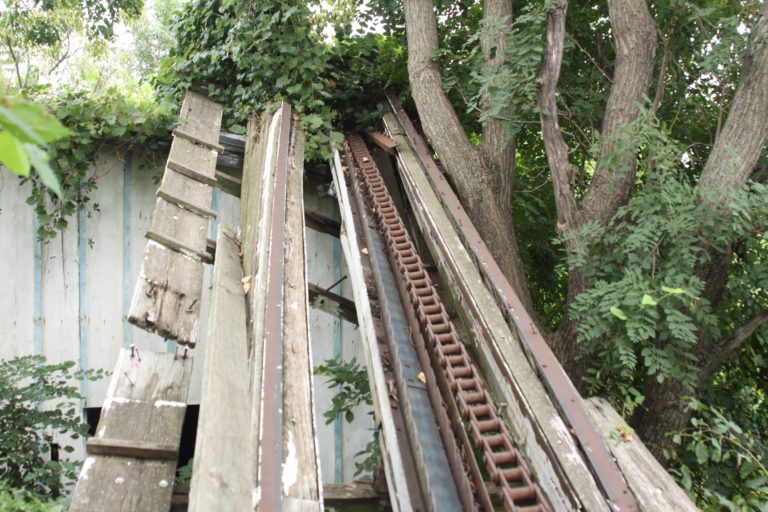

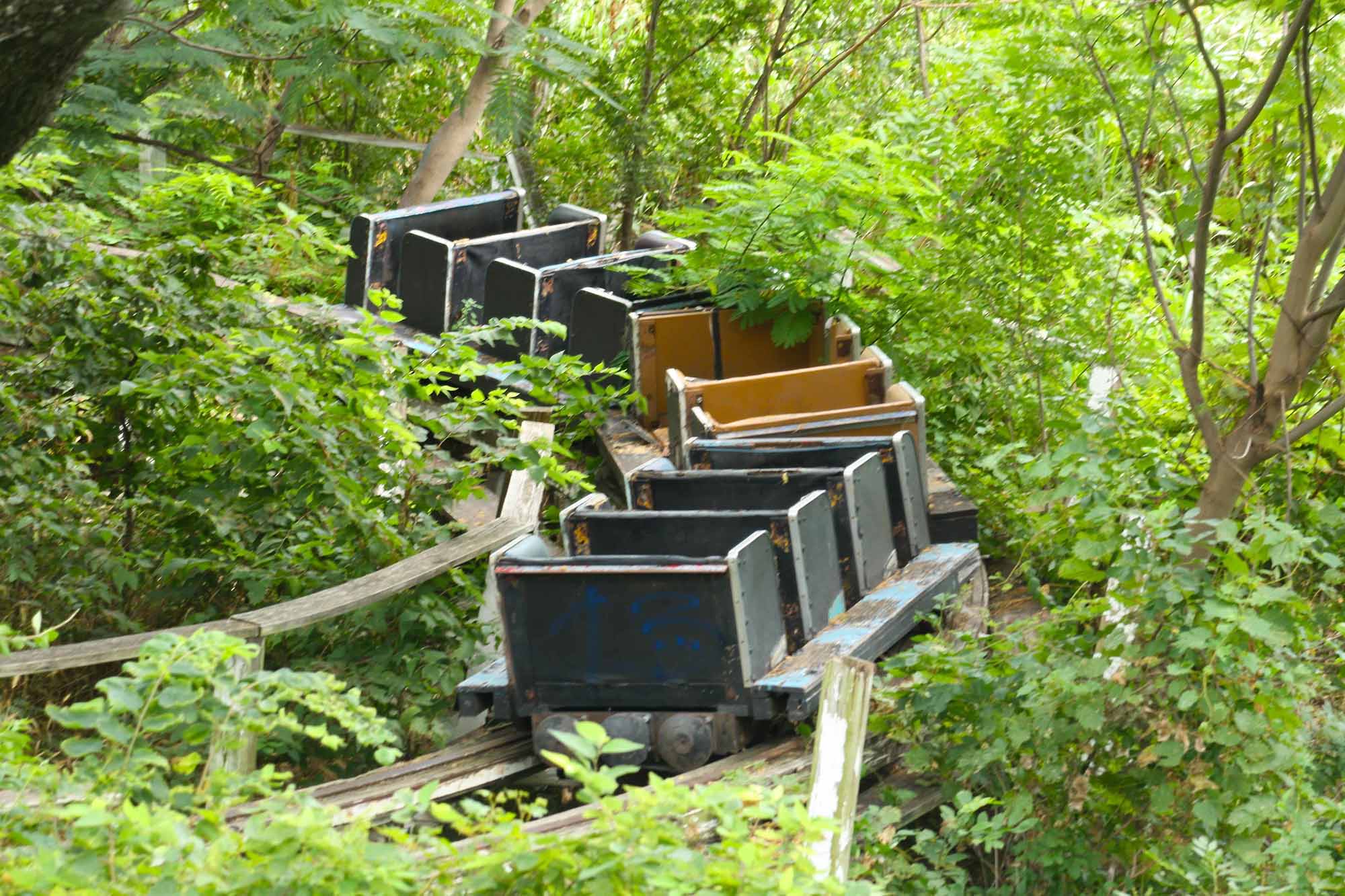
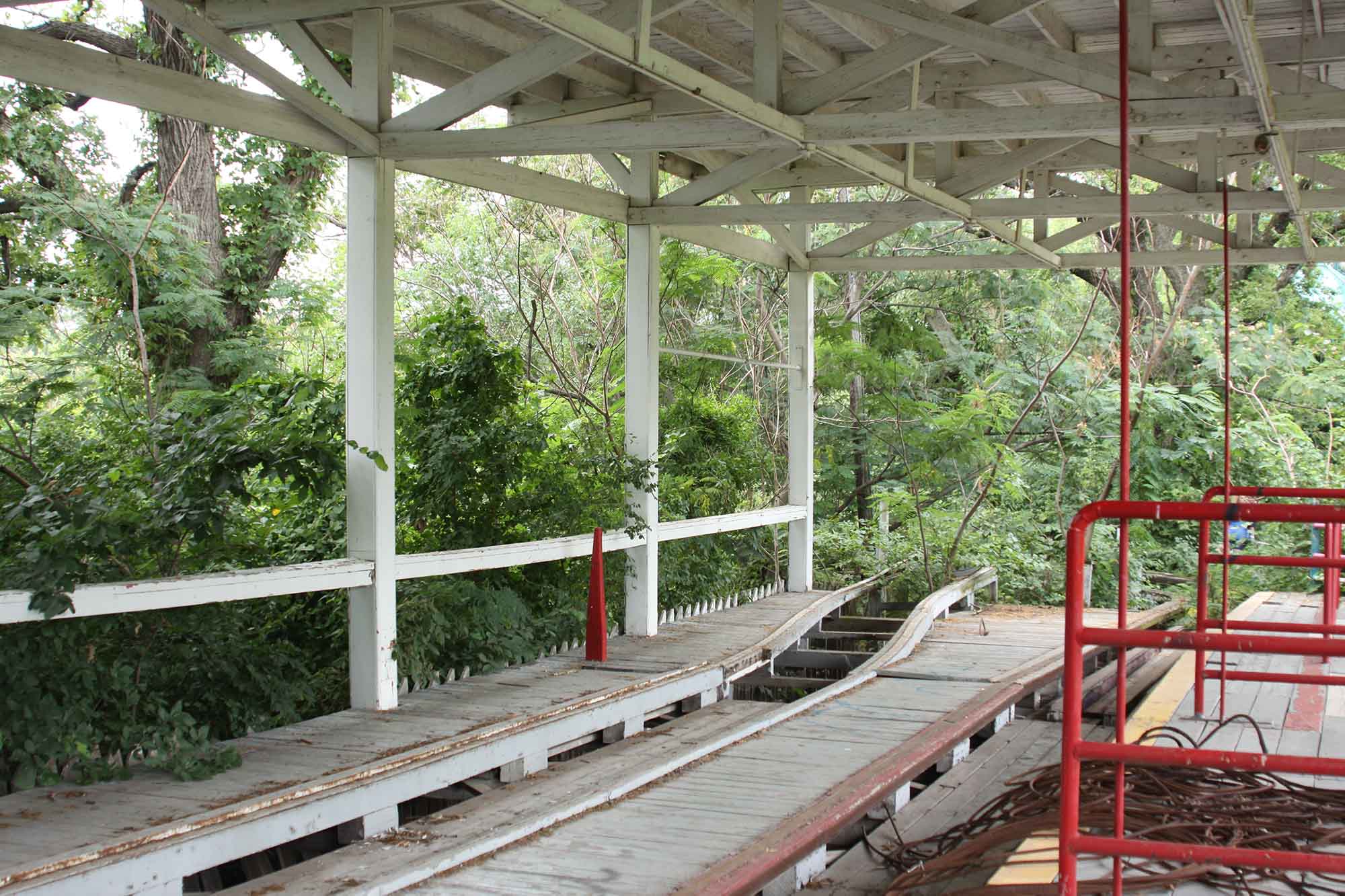
The roller coaster still has the start of the tracks that lead to the first up hill. It was surprising to see the coaster cars still sitting on the tracks completely overgrown with trees and weeds. The cars were deteriorating, but not as bad as I would have thought. The first hill of course had fallen on the loading building and you could not climb any farther. The tracks into the loading bay coming back were also gone. All electrical mechanisms for the coaster were stripped and even the brake was removed or stolen.
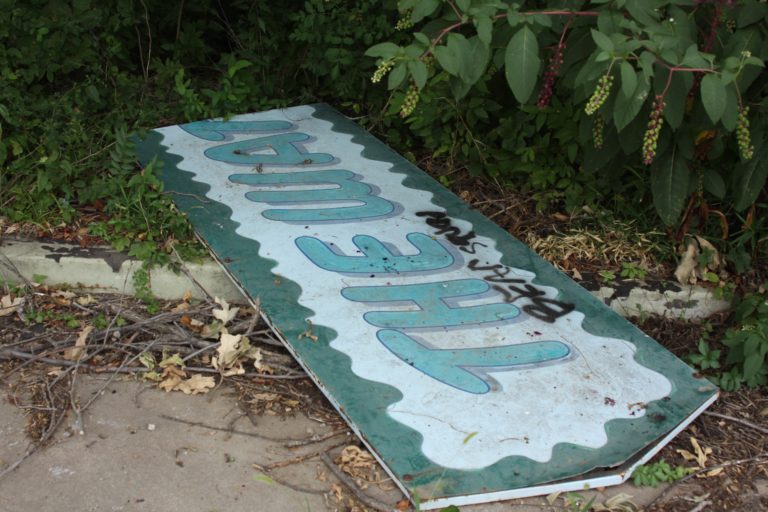
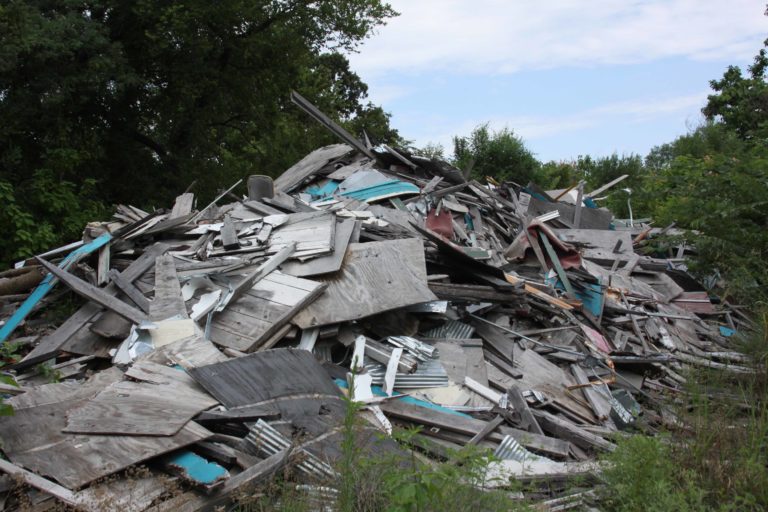
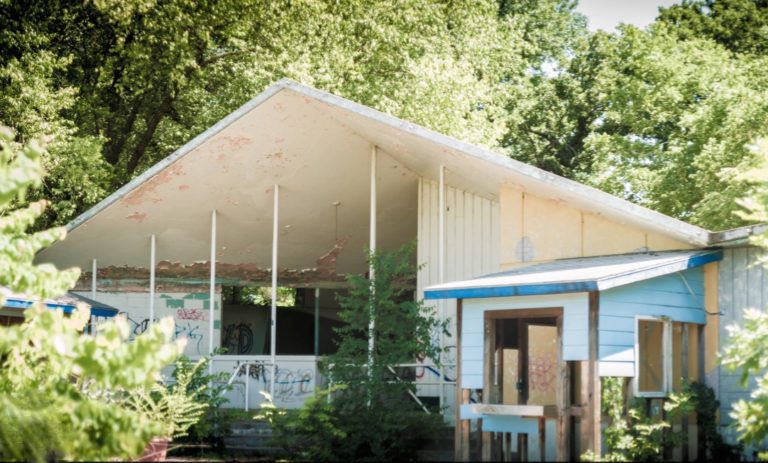

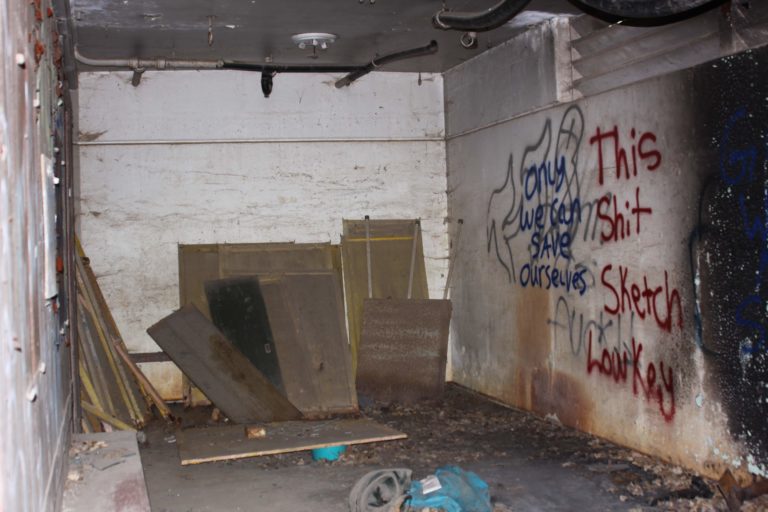

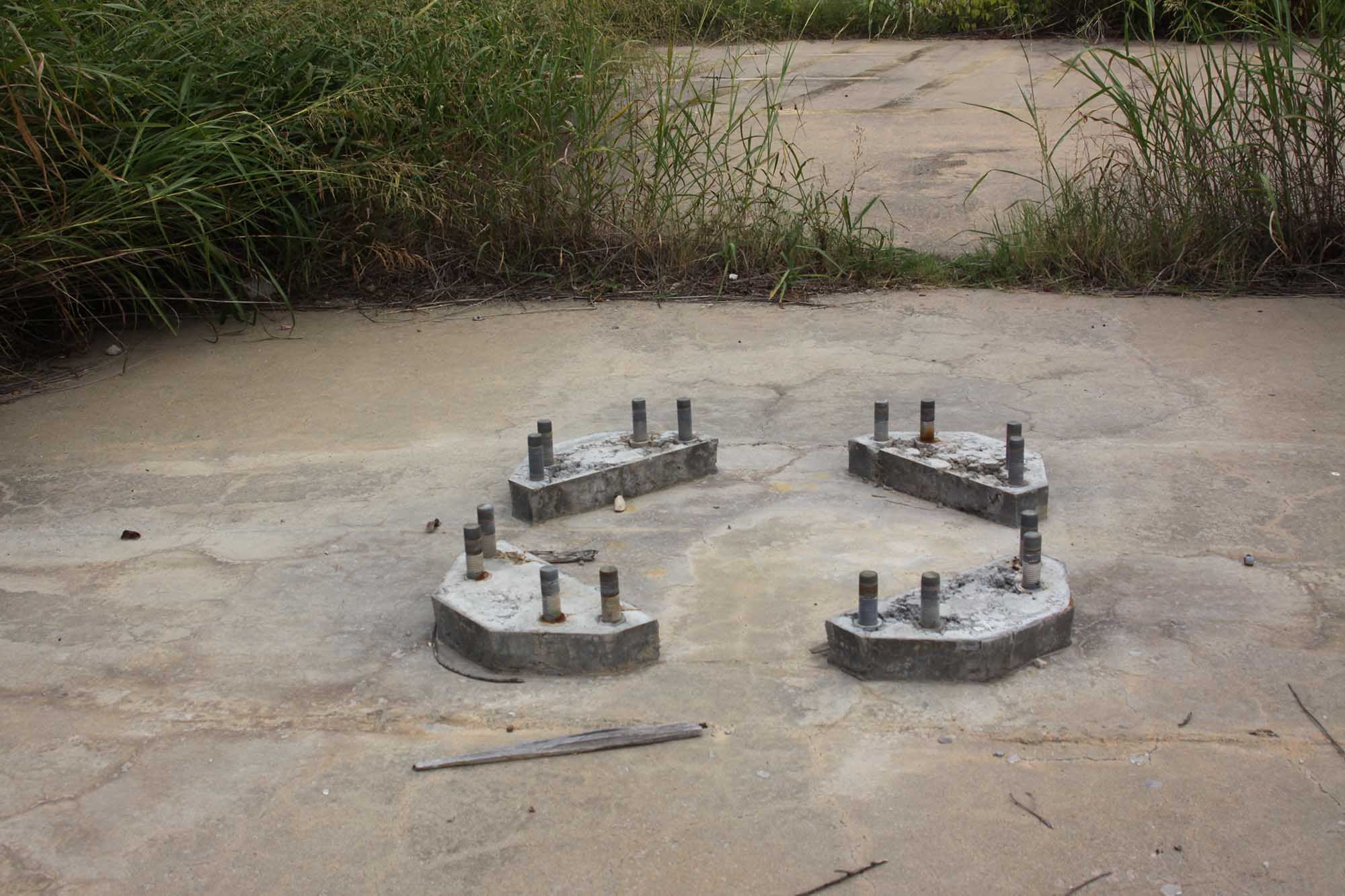
All of the games and concessions have been demolished and removed and the train station has also been torn down and is completely unrecognizable in the overgrowth.
The old pool house still stands, but is heavily tagged and the lower area is filled with smelly standing water. The steps are there with the black chainlink fence visible in the over growth of trees and weeds. The only visible remains of the sky coaster are the anchor bolts left in the concrete.
Someday there will truly be nothing left and it will be sold and turned into a business park or maybe housing. Because it is a flood plane the land is difficult to sell. I still have my memories and now I have some new ones of an eerie and astonishing site of decay and abandonment of a beloved amusement park.
Update… August 2018
The Whacky Shack was completely destroyed by fire.
Update… November 2018
Wichita’s beloved amusement park was sold at auction November 7, 2018. The 57 acre site ultimately sold for $198,00 to Gregory and Tina Dunnegan. The Dunnegans own an outdoor tent rental business. They have plans to turn Joyland into an event center, possibly a site for traveling carnivals, and a paint ball range in the wooded area. This is going to take a lot of demolition and clean up to utilize the historic property. (Wichita Eagle)
Update… June 2019
City Hall approves plan to bring Joyland back to life as a different kind of park Wichita Eagle
Another Wichita Eagle article from June 2019 lays out a possible future for Joyland.
Update… December 2021
Fire breaks out on the Log Jam in the center of the property. KSN.com
Update… December 2021
No progress has been made to re-imagine the property. KSN.com
Source information and to see additional cool abandoned photos check out The Chive – Tommy and James – Wichita Eagle – Revolvy – Wikipedia – AbandonedOK – casa brian
Photo credits as noted and abandonedexplorers.com ©
Amazon Links
Abandonedexplorers.com is a participant in the Amazon Services LLC Associates Program, an affiliate advertising program designed to provide a means for sites to earn advertising fees by advertising and linking to Amazon.
As an Amazon Associate I earn from qualifying purchases.
